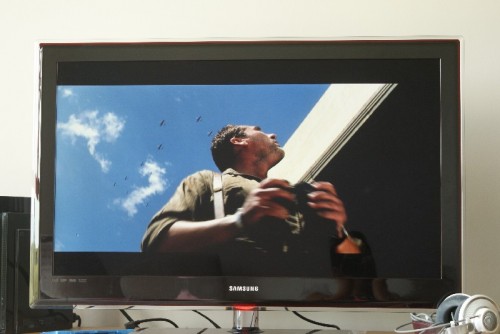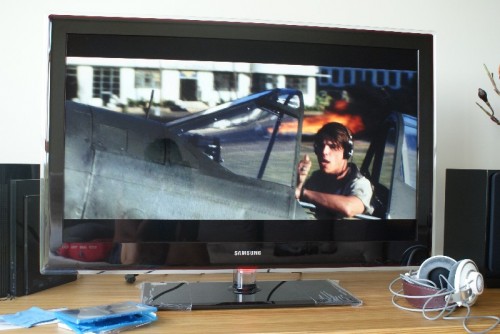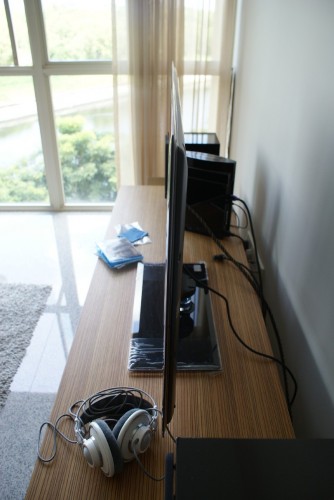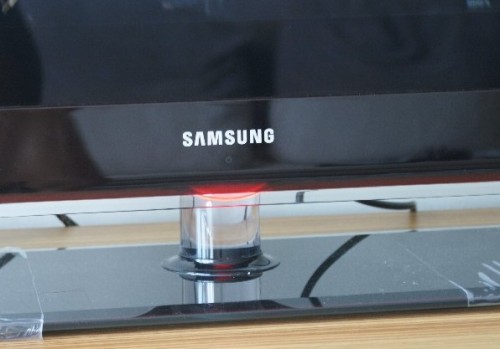
Like many shoppers who’ve been to an electronics store lately, I’ve had a look at Samsung’s incredibly slim B7000 LED TVs (also known as its Series 7 LED TVs) and been pleasantly surprised.
With a depth of under 3cm for the 40-inch model, these svelte beauties never fail to get a reaction when you stare at them from the side – even my parents, non-techies that they are, were shocked to see how thin a screen has become these days.
Yet, looks aside, I never expected to be wowed by the equally stunning image quality on the B7000, which I had a chance to check out closely when Samsung sent us a 40-incher.
Watching regular TV on it, you get the sense that the clarity, sharpness and smoothness of the image are, at most, a small notch up over a good Full HD TV you can get for a third of the price. Sure, the blacks are blacker, the depth is natural, and clearly, with StarHub’s HD programs at 1080i, the B7000 looks pretty sharp, but this is still “just TV”.
What really earns the Full HD B7000 its S$5,399 price tag is Blu-ray movies. I was blown away when I watched Pearl Harbour on the 40-incher, which has 4 HDMI ports to hook up to your PS3, DVD player and other gear.
The sharpness and clarity were the best I’ve seen lately. I’ve had an old Samsung Full HD TV for almost a year now, and seeing the same movie on the B7000 was like doing so with a new pair of glasses for my astigmatism. Characters seem a lot more lifelike, with a sharpness and depth that are not seen on other screens. The same can be said for scenery, which really draws you in with fine detail, such as grass and metal, on-screen.

I suddenly find myself noticing details I never noticed before, like a US soldier running across the screen as a fireball erupts from an aircraft hangar, or the small, desperate sailors rushing on deck as a battleship begins to sink.
Even when a camera tilts up along a tower, as in a scene in Pearl Harbour, or when a plane zooms by in a split second, there is none of that annoying trail of blur. The B7000’s 100Hz engine apparently takes care of that, and your suspension of disbelief is well retained.
Usually, I’d keep a TV’s image settings to “natural” or “standard”, but with the B7000, I actually turned it to “Dynamic” and enjoyed Pearl Harbour tremendously. There’s little of the over-saturation on most other TV’s dynamic settings – here, the more aggressive tuning up actually works.
 Yes, Pearl Harbour’s sky was bluer and the mountains greener, but if you’ve been to Hawaii, you’ll know how it all looks when the sun is up – the B7000 re-creates that lushness stunningly well.
Yes, Pearl Harbour’s sky was bluer and the mountains greener, but if you’ve been to Hawaii, you’ll know how it all looks when the sun is up – the B7000 re-creates that lushness stunningly well.
To have a second look, I then fired up the Batman Begins Blu-ray. Again, the sharpness impresses, as does the contrast. In dim scenes, and there are many in the movie, you can make out outlines of a character better than on regular TV sets.
I’ve praised Pioneer’s plasmas in years past for their natural depth in movies, and Sharp’s LCDs for amazingly fine lines, particularly for games and animation features, say, A Bug’s Life.
But I’m happy to say the B7000 is the king of the hill now if you are looking for everything in a screen. Not just slim. Not just sharp. Not just deep blacks. Not just smooth motion. It’s got them all.
Yes, the B7000 also has as many frills as you’ll find on a TV today – there’s a second, egg-shaped remote, network connectivity, and photo viewing. But ultimately, it’s the image quality that really stands out. Even its slimmess becomes easily forgotten when you see what’s on screen.
If there is an argument against the B7000, it would be that motion can at times seem a little too “computer-like”. That is when a moving object stays very sharply in focus – more so than our eyes and brains are used to. I personally prefer this, up to an extent (I’d say no to Philips’ old PixelPlus, for example), though there are some who prefer a more “natural” image, say, in a plasma.
It’s one of those arguments nobody wins – like whether sound from a set of speakers is warm enough. With the B7000, though, I’d think a large part of its audience – folks used to sharp LCD screens and video games – will welcome the sharpness.
Of course, with a list price of S$5,399 (or over S$4,000 on the street), this is one expensive screen, especially as prices are falling like mad for other Full HD models. All I can say is go to a shop and demo it with a Blu-ray movie, preferably with lots of fast action and explosions, and be prepared to be impressed.






LED TVs have much better contrast and color compared to traditional LCDs ‘*,
LED tvs are getting more and more popular these days eventhough they are still based on LCD Technology”~;
i have seen some LED TVs and they do offer more contrast than LCD TVs:”*
My final review of this t.v is an absolute delight! For the people that can afford this t.v go for it! i have no doubts it will be one very good purchase and you will have many years of enjoyment until the new and more advanced t.vs come out to the public, but to tell you the truth this will blow your mind, with a PS3 or a blue ray player in 1080p resolution with a 5000000 to 1 resolution you can not beat this package enjoy the fruits of your labor with a new Samsung LCD. LED.
I just got 55″ 7000 series before Thanksgiving and it was delivered in time to watch all of the football. All I can say is that you have to see it to believe it.
Can the computer sharp processing be turned off?
How about the S curve? How deep is it?
Can all the wonderfull 3 stars processing be turned off?